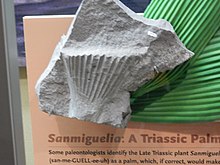| Sanmiguelia | |
|---|---|

| |
| Sanmiguelia fossil at the New Mexico Museum of Natural History and Science | |
| Scientific classification | |
| Kingdom: | Plantae |
| Clade: | Tracheophytes |
| Clade: | Angiosperms (?) |
| Genus: | †Sanmiguelia R.W. Br. (1956)[4] |
| Species: | †S. lewisii
|
| Binomial name | |
| †Sanmiguelia lewisii | |
Sanmiguelia is an extinct plant genus, probably of flowering plants. The genus and the species Sanmiguelia lewisii were first described in 1956 from the Late Triassic Chinle Formation in Colorado,[5][6] and later in Lower Jurassic Moenave Formation in Utah.[7][1] The species has been suggested to be one of the more primitive angiosperm fossils.[8]
Description[edit]
Since Sanmiguelia was first described in 1956, other specimens have been discovered. These suggest that plants were about 60 cm (2 ft) tall, and consisted of a conical stem with helically arranged leaves. The leaves were broadly elliptical, with a pointed apex and a base that clasped the stem. The stems were woody and contained secondary xylem composed of tracheids. Reproductive organs found in the same beds are believed to have belonged to Sanmiguelia. The pollen-bearing organs consist of an axis with many helically arranged microsporophylls, each with a pair of pollen sacs. The ovule-bearing organs consist of an axis bearing structures interpreted as carpels. Pollination is thought to have been carried out by insects.[9]
Taxonomy[edit]
The affinities of Sanmiguelia have proved controversial. When first described, the leaves of Sanmiguelia were described as palm-like.[5] Later an affinity with monocots, in particular Veratrum, was suggested. Others questioned this interpretation and suggested that Sanmiguelia was a cycad. When fossil reproductive structures were assigned to Sanmiguelia, it was considered to be a primitive angiosperm that combined features of both monocots and dicots.[6][9]
References[edit]
- ^ a b Ash, Sidney; Milner, Andrew; Trailo, David Alan. "First known post-Triassic occurrence of the palm-like plant fossil Sanmiguelia Brown". Retrieved January 2, 2021.
- ^ "Sanmiguelia lewisi". The International Fossil Plant Names Index. Retrieved 2024-04-04.
- ^ "Sanmiguelia lewisii Brown, 1956". Yale Peabody Museum of Natural History. Retrieved January 2, 2021.
- ^ "Sanmiguelia". The International Fossil Plant Names Index. Retrieved 2024-04-04.
- ^ a b Brown, Roland W. (1956). "Palm-like plants from the Dolores Formation (Triassic), southwestern Colorado" (PDF). United States Geological Survey Professional Paper, 274H. pp. 205–209. Retrieved March 30, 2024.
- ^ a b Cornet, Bruce (1989). "The Reproductive Morphology and Biology of Sanmiguelia lewisii, and its Bearing on Angiosperm Evolution in the Late Triassic". Evolutionary Trends: In Plants. 3 (1). Palisades, New York, USA: Lamont-Doherty Geological Observatory of Columbia University. Retrieved January 2, 2021.
- ^ "Newly Discovered Plant Fossil". National Park Service. Retrieved January 2, 2021.
- ^ Ash, Sidney (1982). "Occurrence of the Controversial Plant Fossil Sanmiguelia cf. S. lewisi Brown in the Upper Triassic of Utah". Journal of Paleontology. 56 (3): 751–754. JSTOR 1304404.
- ^ a b Taylor, T.N.; Taylor, E.L. & Krings, M. (2009). Paleobotany, The Biology and Evolution of Fossil Plants (2nd ed.). Amsterdam; Boston: Academic Press. ISBN 978-0-12-373972-8. Pages 881–882